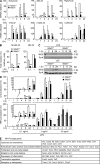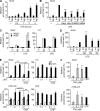Gene expression induced by Toll-like receptors in macrophages requires the transcription factor NFAT5
- PMID: 22312110
- PMCID: PMC3280876
- DOI: 10.1084/jem.20111569
Gene expression induced by Toll-like receptors in macrophages requires the transcription factor NFAT5
Abstract
Toll-like receptors (TLRs) engage networks of transcriptional regulators to induce genes essential for antimicrobial immunity. We report that NFAT5, previously characterized as an osmostress responsive factor, regulates the expression of multiple TLR-induced genes in macrophages independently of osmotic stress. NFAT5 was essential for the induction of the key antimicrobial gene Nos2 (inducible nitric oxide synthase [iNOS]) in response to low and high doses of TLR agonists but is required for Tnf and Il6 mainly under mild stimulatory conditions, indicating that NFAT5 could regulate specific gene patterns depending on pathogen burden intensity. NFAT5 exhibited two modes of association with target genes, as it was constitutively bound to Tnf and other genes regardless of TLR stimulation, whereas its recruitment to Nos2 or Il6 required TLR activation. Further analysis revealed that TLR-induced recruitment of NFAT5 to Nos2 was dependent on inhibitor of κB kinase (IKK) β activity and de novo protein synthesis, and was sensitive to histone deacetylases. In vivo, NFAT5 was necessary for effective immunity against Leishmania major, a parasite whose clearance requires TLRs and iNOS expression in macrophages. These findings identify NFAT5 as a novel regulator of mammalian anti-pathogen responses.
Figures






References
-
- Angulo I., de las Heras F.G., García-Bustos J.F., Gargallo D., Muñoz-Fernández M.A., Fresno M. 2000. Nitric oxide-producing CD11b(+)Ly-6G(Gr-1)(+)CD31(ER-MP12)(+) cells in the spleen of cyclophosphamide-treated mice: implications for T-cell responses in immunosuppressed mice. Blood. 95:212–220 - PubMed
-
- Aramburu J., Drews-Elger K., Estrada-Gelonch A., Minguillón J., Morancho B., Santiago V., López-Rodríguez C. 2006. Regulation of the hypertonic stress response and other cellular functions by the Rel-like transcription factor NFAT5. Biochem. Pharmacol. 72:1597–1604 10.1016/j.bcp.2006.07.002 - DOI - PubMed
-
- Benjamini Y., Hochberg Y. 1995. Controlling the false discovery rate: A practical and powerful approach to multiple testing. J.R. Stat. Soc. Series B Stat. Methodol. 57:289–300
Publication types
MeSH terms
Substances
LinkOut - more resources
Full Text Sources
Molecular Biology Databases

